Civil Technology: Woodworking Grade 12 Questions - NSC Past Papers And Memos September 2020 Preparatory Examinations
Share via Whatsapp Join our WhatsApp Group Join our Telegram GroupREQUIREMENTS:
- ANSWER BOOK
- Drawing instruments
- A non-programmable pocket calculator
INSTRUCTIONS AND INFORMATION:
- This question paper consists of SIX questions: TWO questions are generic and FOUR questions are subject specific.
- Answer ALL the questions.
- Answer each question as a whole. Do NOT separate subsections of questions.
- Start the answer to EACH question on a NEW page.
- Do NOT write in the margins of the ANSWER BOOK.
- You may use sketches to illustrate your answers.
- Write ALL calculations and answers in the ANSWER BOOK or on the attached ANSWER SHEETS.
- Use the mark allocation as a guide to the length of your answers.
- Make drawings and sketches in pencil, fully dimensioned and neatly finished off with descriptive titles and notes to conform to the SANS/SABS Code of Practice for Building Drawings.
- For the purpose of this question paper, the size of a brick should be taken as 220 mm x 110 mm x 75 mm.
- Use your own discretion where dimensions and/or details have been omitted.
- Answer QUESTIONS 2.1, 3.3 and 5.2 on the attached ANSWER SHEETS using drawing instruments where necessary.
- Write your NAME and SURNAME on every ANSWER SHEET and hand them in with your ANSWER BOOK, whether you have used them or not.
- Drawings in the question paper are NOT to scale due to electronic transfer.
QUESTIONS
QUESTION 1: SAFETY AND MATERIALS (GENERIC)
Start this question on a new PAGE.
1.1 Choose the correct requirements regarding scaffolding.
1.1.1 It must have a safety factor of at least 2 / 4. (1)
1.1.2 The width of the wooden solid scaffold platforms is at least 114 mm / 228 mm.(1)
1.1.3 Guard rails must be at least 750 mm / 900 mm in height. (1)
1.1.4 Toe-boards must be at least 150 mm / 1500 mm high. (1)
1.1.5 Platforms must be covered with a non-slip layer / rust free layer. (1)
1.2 Briefly motivate why suspended scaffolding should be as near as possible to the structure were work is being done.(1)
1.3 Identify below THREE regulations for handling hazardous chemical substances as they apply to the supplier providing these chemicals to somebody else.
1.3.1 First aid measures must be indicated.
1.3.2 Origin of the containers must be indicated.
1.3.3 Emergency contact numbers must be indicated.
1.3.4 Fire-fighting measures must be indicated.
1.3.5 Transport routes must be indicated.
1.3.6 Storage instructions must be indicated. (3 x 1) (3)
1.4 What is the minimum and maximum slope of stairs during the construction process?(2)
1.5 Briefly motivate why aluminium ladders must never be used close to electrical wires.(2)
1.6 Describe the difference between a water-based paint and an oil-based paint on a finished surface.(2)
1.7 Name THREE advantages of the curing process of concrete. (3 x 1) (3)
1.8 Describe the process of powder coating. (2)
[20]
QUESTION 2: GRAPHICS, JOINING AND EQUIPMENT (GENERIC)
Start this question on a NEW page.
2.1 Answer the following questions with regard to the site plan on ANSWER SHEET A.
2.1.1 Identify TEN details according to the checklist that are not indicated on the plan. (10 x 1) (10)
2.1.2 Identify SIX details that are incorrectly indicated on the elevation. (6 x 1) (6)
2.2 Make neat sketches to illustrate the following drawing symbols:
2.2.1 Undisturbed earth (2)
2.2.2 Plaster (2)
2.2.3 Ramp with slope of 1 : 5 (2)
2.2.4 Electricity meter (2)
2.2.5 Sink unit – double (2)
2.3 Identify the material illustrated by the following drawing symbols:
2.3.1 ![]() (1)
(1)
2.3.2 ![]() (1)
(1)
2.4 Briefly explain the advantages of the square shoulder screw. (2)
2.5 What is the purpose of the nylon inserts in some nuts? (1)
2.6 What is the screw gauge for an M6/18 Rawl bolt that needs to be drilled? (1)
2.7 FIGURE 2.7 shows the reading of a dumpy level on a telescopic staff. Answer the following questions with regard to the reading.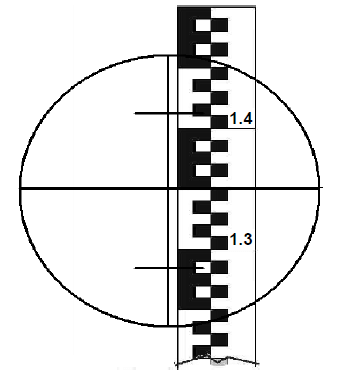
FIGURE 2.7
2.7.1 What is the height reading in FIGURE 2.7? (1)
2.7.2 Determine the distance from the dumpy level to the staff according to the reading in FIGURE 2.7. Show all the calculations. (3)
2.7.3 What is the minimum and maximum distance that could be determined accurately by the dumpy level? (2)
2.8 Briefly motivate why labels and metal plates should be removed from the multi-detector before using the instrument. (1)
2.9 Which precaution must be taken when a multi-detector has not been used for a long period? (1)
[40]
TOTAL SECTION A: 60
QUESTION 3:
CASEMENTS, CUPBOARDS, WALL-PANELLING AND QUANTITIES (SPECIFIC)
Start this question on a NEW page.
3.1 Give ONE word/term for each of the following descriptions by choosing a word/term from the list below. Write only the word/term next to the question numbers (3.1.1–3.1.3) in the ANSWER BOOK, for example. 3.1.4 fanlight.
| stuck mould; rebate; 16 mm; skirting; 15 mm |
3.1.1 The thickness of melamine used for cupboard doors (1)
3.1.2 A mould that is moulded onto a piece of timber (1)
3.1.3 A groove or recess in wood to accommodate a panel, pane, etc. (1)
3.2 FIGURE 3.2 below shows a vertical section through a certain part of a double casement window with a fanlight. Study the picture and answer the questions that follow.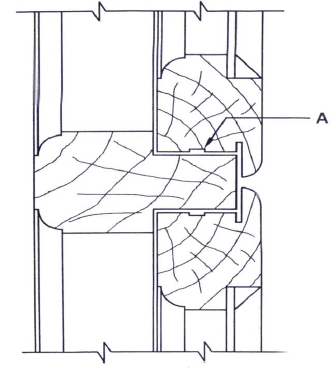
FIGURE 3.2
3.2.1 Identify A. (1)
3.2.2 Name THREE timber parts of the casement and frame. (3)
3.2.3 What is the purpose/function of a fanlight in a double casement? (1)
3.3 Use ANSWER SHEET B and draw, in good proportion, a neat sketch of a vertical section through the top part of a wall panel that ends halfway between the ceiling and the floor.
Use the assessment criteria on the ANSWER SHEET as a guide. (5)
3.4 FIGURE 3.4 below shows the inside of a built-in cupboard without doors. Study the drawing and answer the questions that will follow.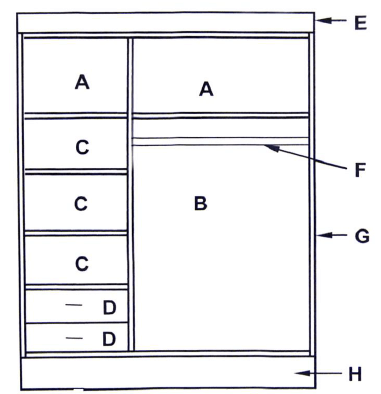
FIGURE 3.3
3.4.1 A well-designed cupboard should consist of four main parts/units. Name the parts/units A to D in the drawing above. (4)
3.4.2 Give a reason for using melamine rather than plain chipboard for the inside of a built-in cupboard. (1)
3.4.3 Identify parts E to H. (4)
3.5 What is the window above the opening of a door or window of a building called? (1)
3.6 FIGURE 3.6 below shows the sectional view of a tongue and groove wall panel from the floor to the ceiling, joined to a 110 mm brick wall. Study the drawing and answer the questions that follow.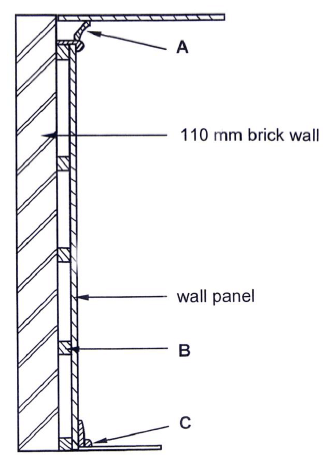
FIGURE 3.6
3.6.1 Identify parts A to C. (3)
3.6.2 Identify TWO reasons for panelling a wall. (2)
3.7 Define a casement window. (2)
[30]
QUESTION 4: ROOFS, CEILINGS, TOOLS AND EQUIPMENT AND MATERIALS (SPECIFIC)
Start this question on a NEW page.
4.1 FIGURE 4.1 below shows two woodworking machines. Study the pictures and answer the questions that follow.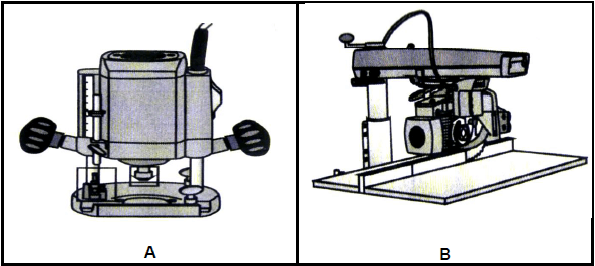
FIGURE 4.1
4.1.1 Identify A and B. (2)
4.1.2 Describe TWO aspects that must be considered when taking care of machine B. (2)
4.1.3 Describe TWO safety aspects that one would check before switching on machine A. (2)
4.2 Name TWO parts of a conventional trap door. (2)
4.3 Describe the first THREE steps that need to be considered when preparing timber before applying preservatives. (3)
4.4 Differentiate between hurricane clips and storm clips regarding the specific roof members that they will secure. (2)
4.5 State TWO properties that are tested in both mechanical and visual grading. (2)
4.6 Name the differences between the following members of a roof:
- King post
- Brandering
- Roof sheeting (3)
4.7 Describe TWO safety aspects of a belt sander. (2)
4.8 FIGURE 4.8 below shows a sectional view through the construction of a trap door. Study the picture below and answer the questions that follow.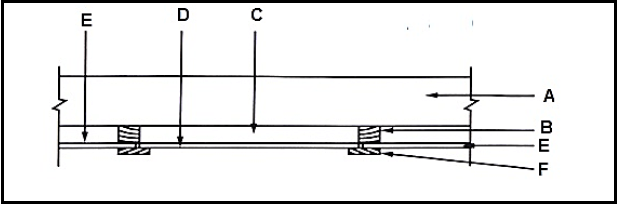
FIGURE 4.8
4.8.1 Identify parts A to E. (5)
4.8.2 Explain the function of part F. (2)
4.8.3 Illustrate by using a hand drawing ONE alternative way of making a trap door. (3)
4.9 FIGURE 4.9 below shows a pictorial view of a roof with a hipped end and a gable end with valley. The roof will be covered with corrugated iron sheeting. Study FIGURE 4.9 and answer the questions that follow.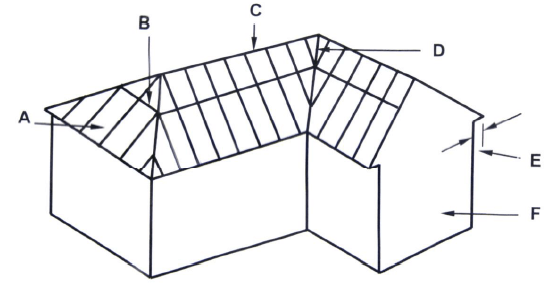
FIGURE 4.9
4.9.1 Identify members A to F. (6)
4.9.2 What are the breadth and thickness of part B in mm? (2)
4.10 Explain TWO characteristics of a good roof covering. (2)
[40]
QUESTION 5: CENTRING, FORMWORK, SHORING AND GRAPHICS AS MEANS OF COMMUNICATION (SPECIFIC)
Start this question on a NEW page.
5.1 Name the material that can be used for the sides of the formwork for a square column. (1)
5.2 Use ANSWER SHEET B and draw to scale 1 : 2 an assembled isometric view of a through haunched mortise/tap and tenon joint to join a stile and a top rail. The timber used is 60 mm wide and 20 mm thick.
Start the drawing from the given corner on ANSWER SHEET C.
Do NOT show hidden details.
Use the assessment criteria on the ANSWER SHEET as a guide. (6)
5.3 Explain the function of the following:
5.3.1 Double-flying shore (1)
5.3.2 Dead shore (1)
5.4 Describe the function of the following components of a dead shore:
5.4.1 Steel dog (1)
5.4.2 Sole plate (1)
5.4.3 Prop/Strut (1)
5.5 FIGURE 5.5 below shows a vertical sectional view through formwork for two concrete beams. Study FIGURE 5.5 and answer the questions that follow.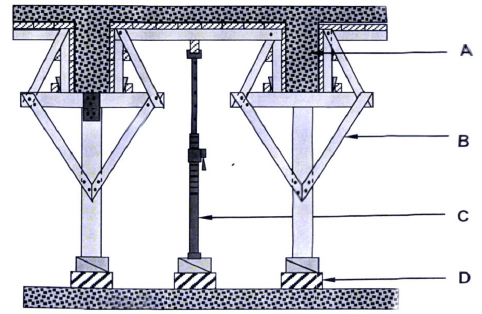
FIGURE 5.5
5.5.1 Identify parts A to D. (4)
5.5.2 Explain the purpose of folding wedges during the construction of formwork. (4)
5.6 Draw in your ANSWER BOOK, in good proportion, a centre for a semicircular arch that will be built over a door opening. Label any TWO parts on the drawing. (6)
5.7 Briefly explain TWO purposes of wedges during the construction of centering. (2)
5.8 Name TWO electrical tools that you could use to cut folding wedges to size. (2)
[30]
QUESTION 6: SUSPENDED FLOORS, STAIRCASES, IRONMONGERY, DOORS AND JOINING (SPECIFIC)
Start this question on a NEW page.
6.1 Explain the purpose of the landing in a staircase. (2)
6.2 Draw in your ANSWER BOOK, in good proportion, a neat line diagram of a staircase. (5)
6.3 Name TWO places where a straight cupboard lock can be used. (2)
6.4 Name a lock that is mounted onto the internal surface of doors to provide extra security. (1)
6.5 Draw in your ANSWER BOOK, in good proportion, a horizontal section through a muntin and raised panels of a three-panel door. (6)
6.6 Explain the purpose of opening A in FIGURE 6.6 below. (1)
FIGURE 6.6
6.7 Study FIGURE 6.7 below which shows the inside bottom corner of a framed ledge and braced door.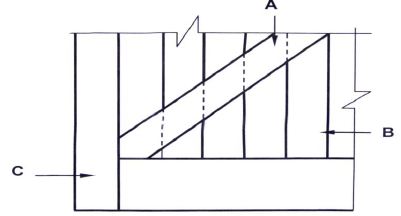
FIGURE 6.7
6.7.1 Identify members A to C. (3)
6.7.2 What is the purpose of the two braces on the door? (1)
6.7.3 Give a reason why stub mortise and tenon joints are preferred on the frame members of the door. (1)
6.8 Draw in your ANSWER BOOK, in good proportion, two horizontal sectional views to show the difference between a door frame and a jamb lining fixed to a wall. Print the title below ONE of these drawings. (6)
6.9 FIGURE 6.9 shows the construction detail of a suspended floor.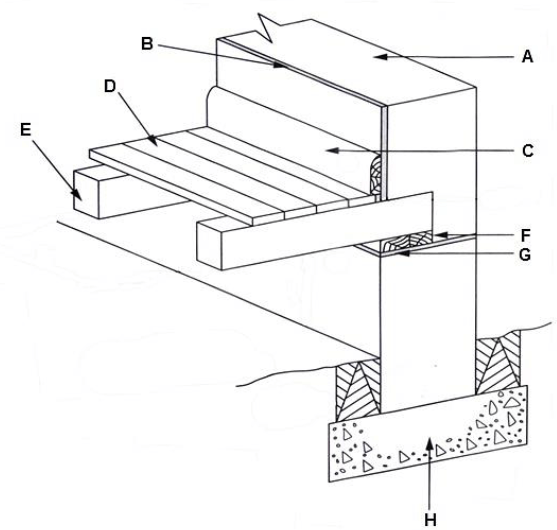
FIGURE 6.9
6.9.1 Name parts A to H. (8)
6.9.2 Briefly motivate the use of part C. (1)
6.9.3 Briefly explain how to determine the size of the floor joistS in suspended floors. (3)
[40]
TOTAL: 200
ANSWER SHEET A
2.1 Answer the following questions with regard to the site plan on ANSWER SHEET A:
2.1.1 Identify TEN details according to the checklist that are not indicated on the plan. (10)
2.1.2 Identify SIX details that are incorrectly indicated on the elevation. (6)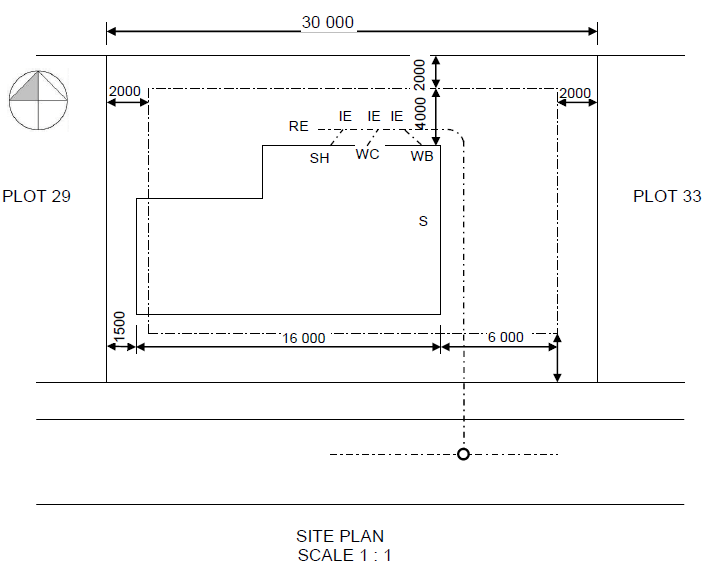
ANSWER SHEET B
ANSWER SHEET 3.3
ASSESSMENT CRITERIA | MARK | CANDIDATE’S MARK |
Wall | 1 | |
Capping | 1 | |
Rough ground | 1 | |
Tongue and groove board | 1 | |
Correctness of drawing | 1 | |
TOTAL: | 5 |
ANSWER SHEET C
ANSWER SHEET 5.2

ASSESSMENT CRITERIA | MARK | CANDIDATE’S MARK |
Stile | 1 | |
Top rail | 1 | |
Mortise | 1 | |
Haunch | 2 | |
Application of scale | 1 | |
TOTAL: | 6 |